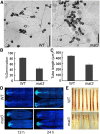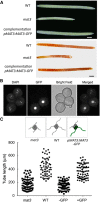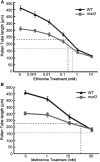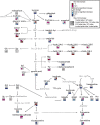S-Adenosylmethionine Synthetase 3 Is Important for Pollen Tube Growth
- PMID: 27482079
- PMCID: PMC5074607
- DOI: 10.1104/pp.16.00774
S-Adenosylmethionine Synthetase 3 Is Important for Pollen Tube Growth
Abstract
S-Adenosylmethionine is widely used in a variety of biological reactions and participates in the methionine (Met) metabolic pathway. In Arabidopsis (Arabidopsis thaliana), one of the four S-adenosylmethionine synthetase genes, METHIONINE ADENOSYLTRANSFERASE3 (MAT3), is highly expressed in pollen. Here, we show that mat3 mutants have impaired pollen tube growth and reduced seed set. Metabolomics analyses confirmed that mat3 pollen and pollen tubes overaccumulate Met and that mat3 pollen has several metabolite profiles, such as those of polyamine biosynthesis, which are different from those of the wild type. Additionally, we show that disruption of Met metabolism in mat3 pollen affected transfer RNA and histone methylation levels. Thus, our results suggest a connection between metabolism and epigenetics.
© 2016 American Society of Plant Biologists. All rights reserved.
Figures







Similar articles
-
METHIONINE ADENOSYLTRANSFERASE4 Mediates DNA and Histone Methylation.Plant Physiol. 2018 Jun;177(2):652-670. doi: 10.1104/pp.18.00183. Epub 2018 Mar 23. Plant Physiol. 2018. PMID: 29572390 Free PMC article.
-
FERONIA receptor kinase interacts with S-adenosylmethionine synthetase and suppresses S-adenosylmethionine production and ethylene biosynthesis in Arabidopsis.Plant Cell Environ. 2015 Dec;38(12):2566-74. doi: 10.1111/pce.12570. Epub 2015 Jul 16. Plant Cell Environ. 2015. PMID: 25988356
-
The cell wall pectic polymer rhamnogalacturonan-II is required for proper pollen tube elongation: implications of a putative sialyltransferase-like protein.Ann Bot. 2014 Oct;114(6):1177-88. doi: 10.1093/aob/mcu093. Epub 2014 May 13. Ann Bot. 2014. PMID: 24825296 Free PMC article.
-
How many receptor-like kinases are required to operate a pollen tube.Curr Opin Plant Biol. 2018 Feb;41:73-82. doi: 10.1016/j.pbi.2017.09.008. Epub 2017 Oct 6. Curr Opin Plant Biol. 2018. PMID: 28992536 Review.
-
Methionine adenosyltransferase (s-adenosylmethionine synthetase).Adv Enzymol Relat Areas Mol Biol. 2011;78:449-521. doi: 10.1002/9781118105771.ch11. Adv Enzymol Relat Areas Mol Biol. 2011. PMID: 22220481 Review. No abstract available.
Cited by
-
Insights into the SAM Synthetase Gene Family and Its Roles in Tomato Seedlings under Abiotic Stresses and Hormone Treatments.Plants (Basel). 2020 May 4;9(5):586. doi: 10.3390/plants9050586. Plants (Basel). 2020. PMID: 32375329 Free PMC article.
-
FIONA1-Mediated m6 A Modification Regulates the Floral Transition in Arabidopsis.Adv Sci (Weinh). 2022 Feb;9(6):e2103628. doi: 10.1002/advs.202103628. Epub 2022 Jan 5. Adv Sci (Weinh). 2022. PMID: 34989479 Free PMC article.
-
Triticale Green Plant Regeneration Is Due to DNA Methylation and Sequence Changes Affecting Distinct Sequence Contexts in the Presence of Copper Ions in Induction Medium.Cells. 2021 Dec 28;11(1):84. doi: 10.3390/cells11010084. Cells. 2021. PMID: 35011646 Free PMC article.
-
Rhytidome- and cork-type barks of holm oak, cork oak and their hybrids highlight processes leading to cork formation.BMC Plant Biol. 2024 Jun 3;24(1):488. doi: 10.1186/s12870-024-05192-4. BMC Plant Biol. 2024. PMID: 38825683 Free PMC article.
-
Whole genome identification, molecular docking and expression analysis of enzymes involved in the selenomethionine cycle in Cardamine hupingshanensis.BMC Plant Biol. 2024 Mar 19;24(1):199. doi: 10.1186/s12870-024-04898-9. BMC Plant Biol. 2024. PMID: 38500044 Free PMC article.
References
-
- Bantignies F, Cavalli G (2011) Polycomb group proteins: repression in 3D. Trends Genet 27: 454–464 - PubMed
Publication types
MeSH terms
Substances
LinkOut - more resources
Full Text Sources
Other Literature Sources
Molecular Biology Databases
Miscellaneous

